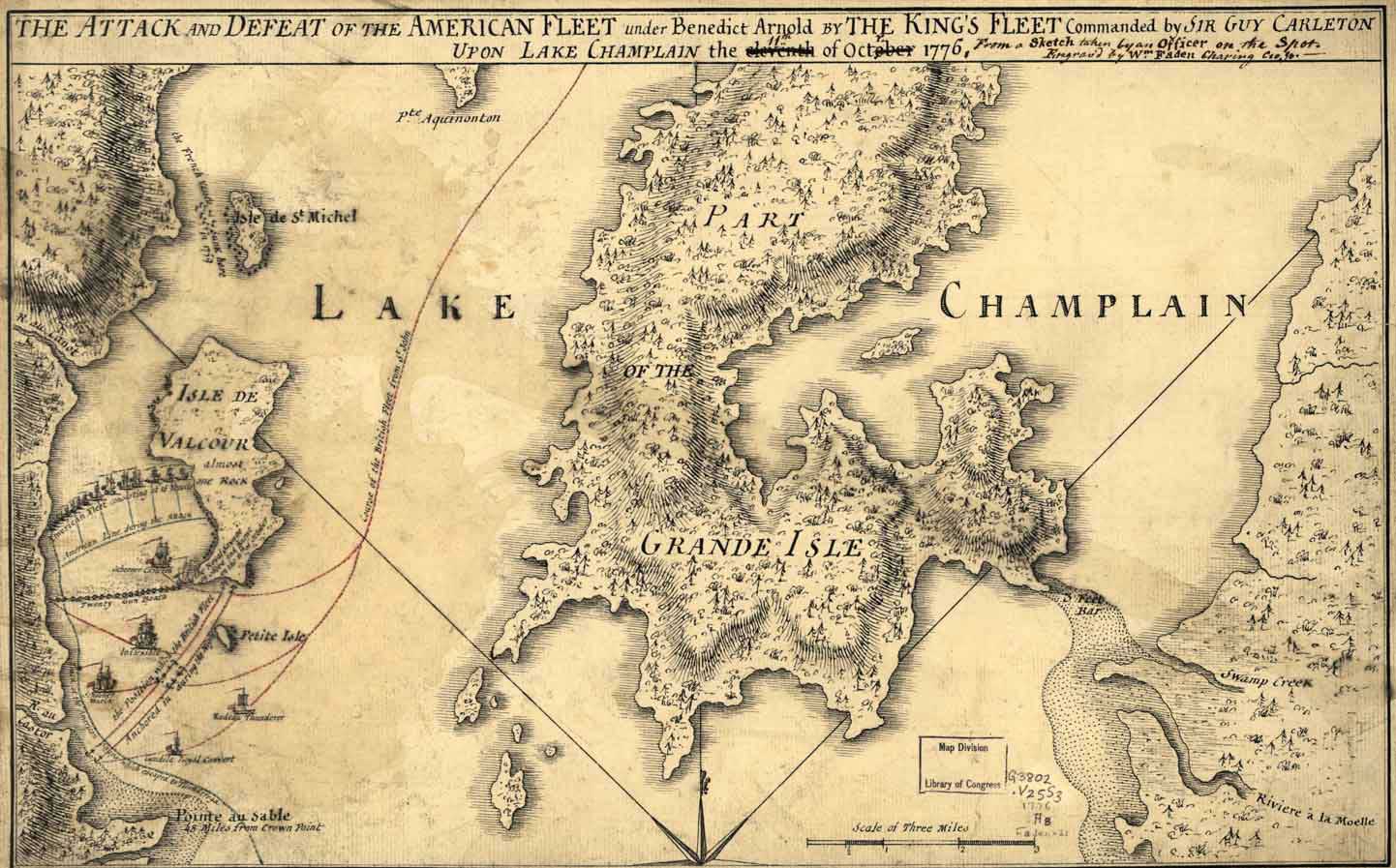Battle of Valcour Bay

In the summer of 1776, Sir Guy Carleton led a large force of British ships and moved down Lake Champlain. To oppose them, American General Arnold had assembled a small force of ships. Arnold's spirited defense against overwhelming odds held back the British long enough to convince Carleton to withdraw for the winter once he had arrived at Fort Ticonderoga.
.
The American failure to capture Canada, provided the British with the opportunity to use it as location to launch an attack on the Americans. Sir Guy Carleton, the British commander in Canada, had been instructed to invade New York by way of Lake Champlain. Carleton was ordered to secure the Mohawk Valley and the upper waters of the Hudson.
During the summer of 1776, Carleton worked to build and buy a fleet with which to obtain control of Lake Champlain. Obtaining control of Lake Champlain was an arduous task. Three large York vessels were sent over from England. The vessels proceeded up the St. Lawrence, as far as the rapids. At the rapids the vessels were taken to pieces and carried overland to St. John's. Then, the vessels were reassembled at St. John's. Twenty gunboats and more than two hundred flat-bottomed transports were built at Montreal. These vessels were manned with 700 picked seamen and gunners. Carleton embarked on this flotilla with his army of 12,000 men.
Benedict Arnold had been working all the summer with desperate energy to oppose the threatened invasion. In June, the materials for Arnold's navy were growing in the forests of Vermont. Though his carpenters with their tools, his sailmakers with their canvas, and his gunners with their guns had to be brought from the coast towns of Connecticut and Massachusetts. By the end of September Arnold had built a little fleet, consisting of three schooners, two sloops, three galleys, and eight gondolas. Arnold outfitted his flotilla with seventy guns and as many seamen and gunners as he could gather together.
Arnold knew his flotilla was not large enough to stop the much larger British force, but his goal was to delay them. He hoped, by putting up an heroic defense, he could raise the spirits of the people and spur them on to further resistance. To allow Carleton to reach Ticonderoga without opposition would be disheartening to colonists. Whereas if the British were opposed and delayed, the colonists might hope to dampen the enthusiasm of the invaders. With this end in view, Arnold proceeded down Lake Champlain, far to the north of Crown Point. He took up a strong position between Valcour Island and the western shore. Arnold had both his wings covered. As a result, he could only be attacked in front. Arnold lay in wait for the enemy.
On the 11th of October, Sir Guy Carleton's squadron approached the American lines. There, the first battle fought between an American and a British fleet ensued. At sundown, after a desperate fight of seven hours' duration, the British withdrew out of range. However, the British intended to renew the struggle in the morning. Both fleets had suffered severely. Though the Americans were so badly cut up, that Sir Carleton expected to force them to surrender the next day. Surprisingly, during the hazy night, Arnold contrived to slip through the British line with all that was left of his crippled flotilla. The forces Arnold commanded made way for Crown Point with all possible speed. Arnold had to stop once to mend leaks. He stopped once to take off men and guns from two gondolas which were sinking. Nevertheless, by dint of sailing and kedging, Arnold got such a start that the enemy did not overtake him until the next day, when he was nearing Crown Point.
Arnold ordered the rest of the American fleet to sail for their haven. Meanwhile, Arnold and his schooner engaged in an ugly fight, lasting four hours with the three largest British vessels. One of the British fighting vessels mounted eighteen twelve pound cannons. Arnold's vessel was terribly cut up in the skirmish. Her deck was covered with dead and dying men. After having sufficiently delayed the enemy, Arnold succeeded in running the schooner aground in a small creek. Then he set the ship on fire.
Then Arnold marched through woodland paths to Crown Point. There, Arnold's other vessels had disembarked their men. Arnold brought away his whole force in safety to Ticonderoga. When Carleton appeared before that celebrated fortress, he found it strongly defended. Carleton doubted his ability to reduce Ticonderoga before the cold weather set in. Carleton decided to take his army back to Canada. He was satisfied, for the present, with having gained control of Lake Champlain.
Carleton's sudden retreat astonished both friends and foes. He was blamed for it by his generals, Burgoyne, Phillips, and Riedesel, as well as by the King. When it became clear how easily the fortress was seized by Phillips in the following summer, there was hardly any doubt that Carleton's decision was a grave mistake.
 >
>